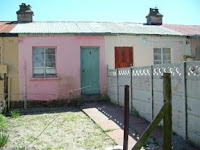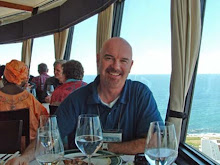



My last day in Cape Town was remarkable because we decided to do something less typically touristy (although we had a tour guide for it). Rebekah and I went for a township tour. Brian, our tour guide was born in District Six, a large neighbourhood adjacent to the downtown that, up until the 1960’s was a mix of black, white, mixed, Jewish, Christian, Muslim, short and tall. You get the idea. Although perhaps sentimentalized, the pictures and text at the District Six museum show a neighbourhood that was vibrant, alive, and appeared to get along. The apartheid government of the time decreed that this should become a white neighbourhood; the goal being to make the city white and move all the non-whites to the suburbs and beyond. Systematically, residents were forced out and relocated to the townships – new neighbourhoods that were designated for blacks or coloureds. As they moved out, the houses were razed by bulldozers. The only buildings that escaped were several churches and mosques, and a handful of businesses that were on the edges, facing the existing white neighbourhoods. The picture above shows the field that was District Six.
The site of District Six remains empty except for those few churches and mosques – no new development has taken place in the intervening 40 years. Because of the unrest of the time, and the resistance by the residents, no one has taken up the offer of developing the area. Whether through solidarity with the removed residents, or from fear of retribution, potential residents never arrived, and except for a few cobbled sections of street and bits of foundations and steps, the area is grassland – not even shacks have been built. There is a growing demand for former residents to be returned to the area into new housing, and one housing complex of about 24 townhouses has been built for the most senior of the former District Six residents.
Most black and coloured (again, these are the Cape Town terms – people use them to describe themselves) live in the townships, areas specifically designated and created for them by the apartheid government. Formal townships tend to consist of streets with small houses closely packed along them. Informal settlements spring up all over on unoccupied lands. Sometimes these are strips of land alongside the road – eight or ten feed wide – others consists of hectares of tiny shacks made of scrap sheet metal, wood, cardboard or whatever comes to hand. The ‘street’s are little more than walkways between them. The largest township “name” consists of both formal and informal housing, and has a population of over a million.
Proper houses consist of two or three rooms, usually with electricity, water, and sewage (although this may be shared by other houses). Most of the shacks have no facilities, and draw water from a communal tap, use portable out-houses, and heat and cook with kerosene. Because of the huge fire hazard, the city has started providing electrical service. The extraordinary thing too, is that the city is designating land for shacks, by laying water lines, sewage pipes (the toilet it attached to the pipe, but the out-house isn’t built by the city, so you come across these toilets sitting in an open area), and electric poles in anticipation of people building shacks. Thousands of people arrive every week to the settlements – Brian showed us a whole area that didn’t exist the week before.

No comments:
Post a Comment